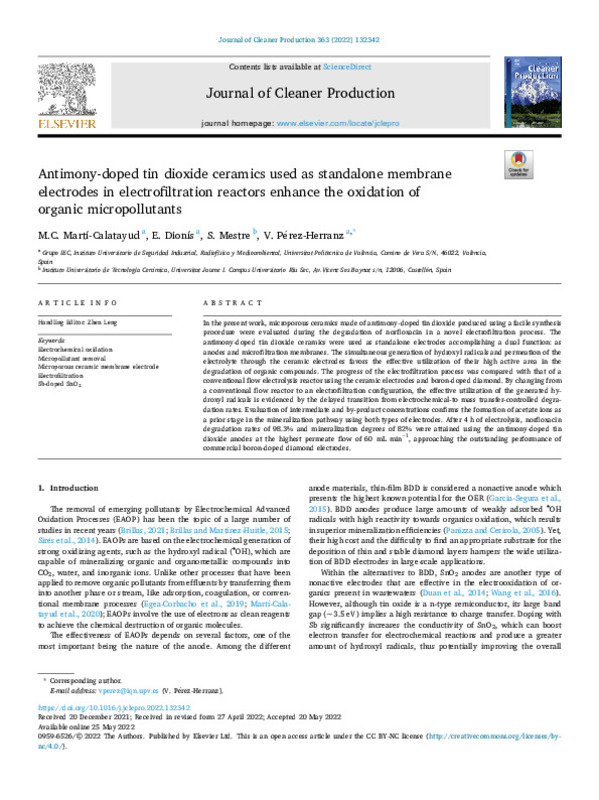JavaScript is disabled for your browser. Some features of this site may not work without it.
Buscar en RiuNet
Listar
Mi cuenta
Estadísticas
Ayuda RiuNet
Admin. UPV
Antimony-doped tin dioxide ceramics used as standalone membrane electrodes in electrofiltration reactors enhance the oxidation of organic micropollutants
Mostrar el registro sencillo del ítem
Ficheros en el ítem
| dc.contributor.author | Martí Calatayud, Manuel César
|
es_ES |
| dc.contributor.author | Dionis, E.
|
es_ES |
| dc.contributor.author | Mestre, S.
|
es_ES |
| dc.contributor.author | Pérez-Herranz, Valentín
|
es_ES |
| dc.date.accessioned | 2023-05-26T18:01:45Z | |
| dc.date.available | 2023-05-26T18:01:45Z | |
| dc.date.issued | 2022-08-20 | es_ES |
| dc.identifier.issn | 0959-6526 | es_ES |
| dc.identifier.uri | http://hdl.handle.net/10251/193629 | |
| dc.description.abstract | [EN] In the present work, microporous ceramics made of antimony-doped tin dioxide produced using a facile synthesis procedure were evaluated during the degradation of norfloxacin in a novel electrofiltration process. The antimony-doped tin dioxide ceramics were used as standalone electrodes accomplishing a dual function: as anodes and microfiltration membranes. The simultaneous generation of hydroxyl radicals and permeation of the electrolyte through the ceramic electrodes favors the effective utilization of their high active area in the degradation of organic compounds. The progress of the electrofiltration process was compared with that of a conventional flow electrolysis reactor using the ceramic electrodes and boron-doped diamond. By changing from a conventional flow reactor to an electrofiltration configuration, the effective utilization of the generated hydroxyl radicals is evidenced by the delayed transition from electrochemical-to mass transfer-controlled degradation rates. Evaluation of intermediate and by-product concentrations confirms the formation of acetate ions as a prior stage in the mineralization pathway using both types of electrodes. After 4 h of electrolysis, norfloxacin degradation rates of 98.3% and mineralization degrees of 82% were attained using the antimony-doped tin dioxide anodes at the highest permeate flow of 60 mL min- 1, approaching the outstanding performance of commercial boron-doped diamond electrodes. | es_ES |
| dc.description.sponsorship | Acknowledgements The authors thank the financial support through the project RTI2018-101341-B-C21 funded by MCIN/AEI/10.13039/501100 011033/ (Spain) and by FEDER A way of making Europe. | es_ES |
| dc.language | Inglés | es_ES |
| dc.publisher | Elsevier | es_ES |
| dc.relation.ispartof | Journal of Cleaner Production | es_ES |
| dc.rights | Reconocimiento - No comercial - Sin obra derivada (by-nc-nd) | es_ES |
| dc.subject | Electrochemical oxidation | es_ES |
| dc.subject | Micropollutant removal | es_ES |
| dc.subject | Microporous ceramic membrane electrode | es_ES |
| dc.subject | Electrofiltration | es_ES |
| dc.subject | Sb-doped SnO 2 | es_ES |
| dc.subject.classification | INGENIERIA QUIMICA | es_ES |
| dc.title | Antimony-doped tin dioxide ceramics used as standalone membrane electrodes in electrofiltration reactors enhance the oxidation of organic micropollutants | es_ES |
| dc.type | Artículo | es_ES |
| dc.identifier.doi | 10.1016/j.jclepro.2022.132342 | es_ES |
| dc.relation.projectID | info:eu-repo/grantAgreement/AEI/Plan Estatal de Investigación Científica y Técnica y de Innovación 2017-2020/RTI2018-101341-B-C21/ES/ELECTROCHEMICAL CHARACTERIZATION OF CERAMIC ELECTRODES AND MEMBRANES AND APPLICATION TO PHOTOELECTROOXIDATION AND ELECTROFILTRATION PROCESSES/ | es_ES |
| dc.rights.accessRights | Abierto | es_ES |
| dc.contributor.affiliation | Universitat Politècnica de València. Escuela Técnica Superior de Ingenieros Industriales - Escola Tècnica Superior d'Enginyers Industrials | es_ES |
| dc.description.bibliographicCitation | Martí Calatayud, MC.; Dionis, E.; Mestre, S.; Pérez-Herranz, V. (2022). Antimony-doped tin dioxide ceramics used as standalone membrane electrodes in electrofiltration reactors enhance the oxidation of organic micropollutants. Journal of Cleaner Production. 363:1-9. https://doi.org/10.1016/j.jclepro.2022.132342 | es_ES |
| dc.description.accrualMethod | S | es_ES |
| dc.relation.publisherversion | https://doi.org/10.1016/j.jclepro.2022.132342 | es_ES |
| dc.description.upvformatpinicio | 1 | es_ES |
| dc.description.upvformatpfin | 9 | es_ES |
| dc.type.version | info:eu-repo/semantics/publishedVersion | es_ES |
| dc.description.volume | 363 | es_ES |
| dc.relation.pasarela | S\483739 | es_ES |
| dc.contributor.funder | AGENCIA ESTATAL DE INVESTIGACION | es_ES |
| dc.contributor.funder | European Regional Development Fund | es_ES |
| dc.subject.ods | 06.- Garantizar la disponibilidad y la gestión sostenible del agua y el saneamiento para todos | es_ES |
| upv.costeAPC | 3280 | es_ES |








